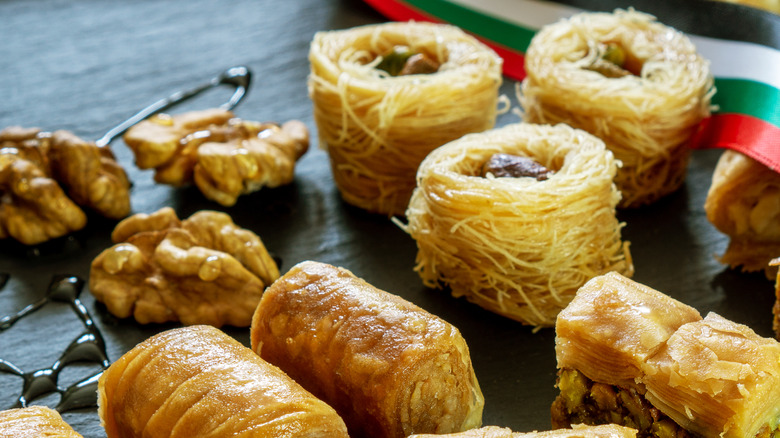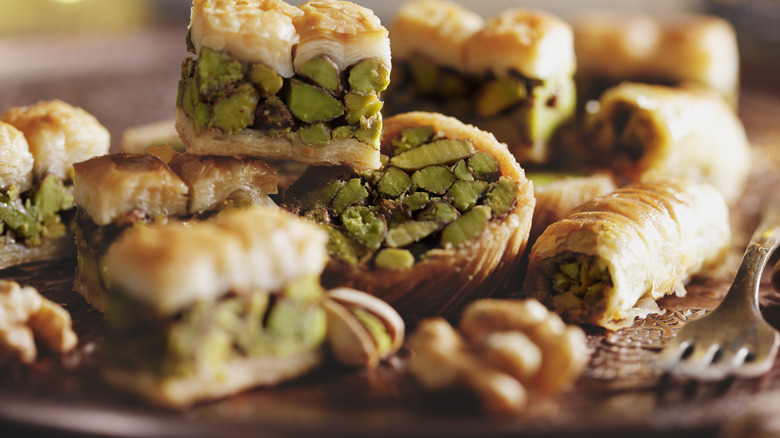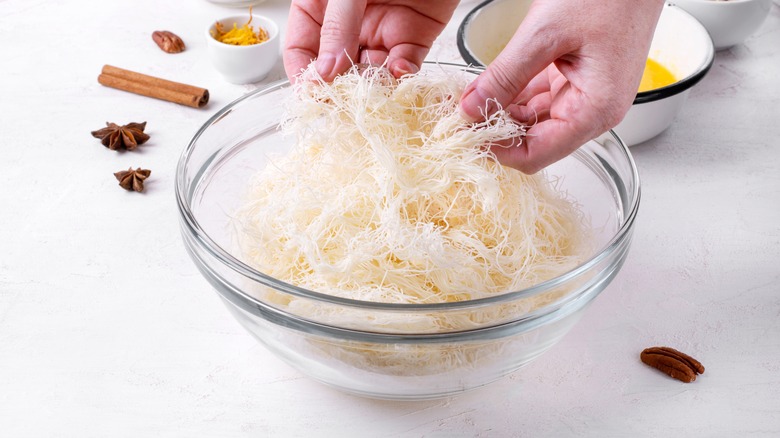What Is Borma And How Is It Made?
If you've ever ordered baklava at a Middle Eastern or Turkish restaurant, you will be aware that it often comes in various shapes. A few things are standard: the nuts (often pistachios, cashews, or some form of pine kernel), the honey or sweetened syrup, and the light and crispy pastry.
From there, though, characteristics start to branch out a bit. And there's a good chance that in your box or plate of baklava, you've seen the pieces with thread-thin strands of crunchy dough wrapped around the nuts, almost like a bird's nest. This particular form of baklava is known as borma, sometimes also spelled "burma," though not to be confused with the South Asian country some 6,000 miles away. The Arabic name literally translates to "rounded."
The tightly wound bird's nest strands are formed from a specific kind of delicate dough distinct from filo dough that appears in other forms of baklava. This dough is known as knafeh, also often spelled "kunafa" or alternately called "kataifi." Libanais Sweets is a major producer of Middle Eastern desserts in the United States. It makes borma using a simple combination of flour and water, but creating it entails a unique process to produce thin strands of dough.
Go nuts!
There are different takes on how to make the best knafeh (more on that below), but knafeh can also be purchased pre-made online, at any number of middle eastern grocers, or, depending on your location, your local grocery store. When making borma, the knafeh is laid out in long strings. Crushed or chopped nuts are added, then the knafeh is carefully rolled into tight cylinders.
The cylinders are left to rest for about 24 hours. Then a layer of butter or ghee is poured over the top and baked for about an hour. After coming out of the oven, the remaining butter and the sugar syrup or honey are applied. The cylinders are again left to rest for another 24 hours, then placed on a baking rack or other porous surface for about ten hours to let the excess syrup drip dry. The cylinders are then sliced into smaller pieces and served.
It is a time-consuming process, taking over two days to reach the final product. Even a time-saving baklava hack won't cut down on that. But it's worth it. The concentration of nuts in the center adds to the crunch, and the sweetness of the syrup brings the sticky chewiness that's so familiar and beloved in baklava.
All about the knafeh
Yes, Knafeh can be purchased pre-made, but you can also make it yourself. It also seems to be one of those foods with various methods and recipes, depending on who you ask. Though Libanais uses only flour and water to make knafeh, other recipes call for a few more ingredients. Dainty Delicacy, for example, uses a recipe that also calls for corn flour, salt, and oil. Regardless of what ingredients are used, after the mixture is blended into a thin, liquid-like paste, it is poured into a bottom-ventilated vessel and set on a hot surface, according to Libanais.
The Dainty Delicacy video shows how one can make knafeh dough by funneling it through a piping bag with a very small opening. The dough goes onto a heated pan on the stove, where it is lightly cooked before being scooped off onto a plate. It can then be stored for baking later, though if you intend to make borma right this minute, you'll want to bake it directly after it's cooled.
Knafeh doesn't just show up in borma or baklava. In fact, it has its own dessert dish named after it (depending on the region), which sees a layer of the crispy dough served with soft goat cheeses. An easy entrance into the world of making borma is by first mastering knafeh.


